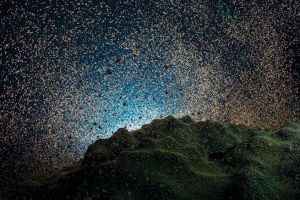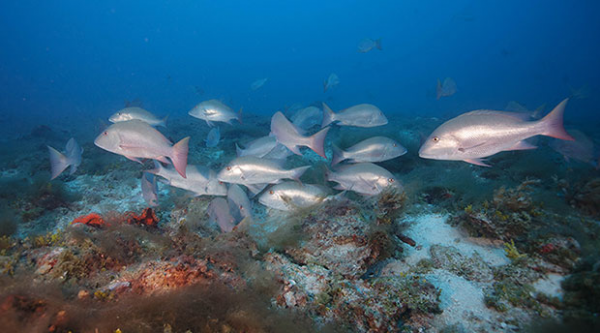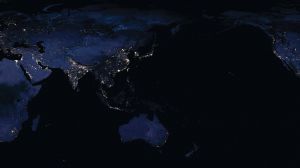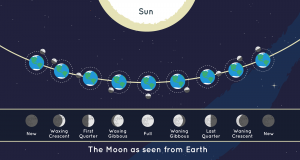Moon
Effects of the Moon on Reef Organisms
Abstract
The moon contributes to many important factors among reef organisms that help those ecosystems grow. Moon phases, light, and cycles each play a part in the process of coral spawning and species fertilization. There are other characteristics such as water temperature and water acidification that help with this too but without the moon, many organisms would struggle to fertilize gametes and grow into larval fish successfully. Some organisms also rely on the moon to cue other behaviors essential for survival. For example, many species such as manta ray, zooplankton, and isopods migrate to the shore which creates a great environment for both prey and predators. The prey seek the moonlight to identify predators better and the predators use this false sense of security to lure their prey out. Unfortunately, the effects of the moon have been inhibited by factors such as light pollution. Other forms of pollution have also played a role in destroying reef ecosystems by causing ocean acidification and the rise of temperature. It is essentially our responsibility to limit these variables and allow for the maximization of reproduction and growth in marine ecosystems.
Introduction
The moon plays an important role in the underwater world. Many marine organisms rely on biological clocks synced with the moon that influence their behaviors [1]. In addition, the moon also impacts tides and currents. According to David Wilcockson, a marine biologist at Aberystwyth University in Wales, "when the moon is full or new, it is directly in line with Earth and the sun, exerting a strong pull on the ocean and thus causing more pronounced tides." Oppositely, when the moon is only half-full it causes neap tides, the weakest tide. This interaction between the moon, tides, and biological clocks is especially notable when considering reproductive behavior.
Synchronous spawning, a type of external fertilization, is observed in many marine organisms, including corals [2]. According to the National Oceanic and Atmospheric Administration, synchronous spawning occurs when "entire colonies of coral reefs simultaneously release their tiny eggs and sperm, called gametes, into the ocean" [3]. This phenomenon occurs at night and is influenced by environmental cues such as sea temperature and lunar cycles. Sea temperature and gamete maturation determine the spawning month while lunar cycles determine spawning day [4]. Moonlight also impacts spawning by acting as a signal for corals and other organisms to release their gametes.
Moon Phases
There are eight phases of the moon: new moon, waxing crescent, first quarter, waxing gibbous, full moon, waning gibbous, last quarter, and waning crescent [5]. Only half of the moon is illuminated by the sun while the remaining half is dark. The part of the moon visible from earth depends on the moon's orbit.

Moon phases, specifically the full moon, are an important environmental cue that leads to the synchronous spawning of coral. The majority of corals spawn a few days after a full moon, however, there are a handful of corals with irregular spawning habits, such as the Diploria labyrinthiformi which spawns closer to the new moon [2]. Scleractinian corals are one of the most studied lunar-spawning corals. These broad-cast spawning corals release their gametes after the full moon, however the specific number of days after the full moon varies. Sea temperature and wind speed before the full moon account for this inconsistency in spawning days. Therefore, corals have the ability to adjust their behavior in accordance with environmental cues to maximize reproductive success [6].
Not only is the moon phase important for synchronous spawning but also for other organismal behaviors. For example, the giant manta ray tends to migrate towards nearshore habitats during the full and new moon phases [7]. Studies have also shown that demersal zooplankton is affected by changes in moon phases. A study conducted in the Great Barrier Reef discovered that 14 out of 17 species of demersal zooplankton appeared in greater numbers during the quarter and new moon phases. Gnathiid isopods, a type of marine demersal zooplankton, are crucial to coral reef ecosystems. They are an ectoparasite and a principal food source for cleaner fish and shrimp. The activity of gnathiid isopods is influenced by the different phases of the moon. Infestation by gnathiids was found to peak at night in reefs in the eastern Caribbean. Additionally, larger gnathiids tend to appear at night. Studies of gnathiid isopods on the Great Barrier Reef found greater densities of isopods during the new and full moons. The moon is a critical environmental cue for many marine organisms. Moon phases dictate organismal behavior in order to create harmonious marine ecosystems.
Reef fish are also directly influenced by moon phases, both in when and where they spawn, as well as general movement to and from the reefs. When the moon phase reaches a full moon or new moon, reefs experience what is known as peak tidal ranges, and reefs experience much higher moonlight than usual. This is said to result in increased movement of reef fish, as well as increased foraging by diurnal fish, such as angelfish and butterflyfish. Smaller fish move into deeper waters when the tides are lower, to avoid becoming trapped in tide pools. These moon phases also coincide with the spawning periods of reef fish. These periods often occur at either the new moon or full moon, and in some cases can occur at either. By all spawning at the same time, reef fish guarantee better survivability of their offspring, increasing the benefit of these moon phases to spawning.[8]

Moonlight
Moonlight plays a crucial role in the spawning of coral by signaling many species to release their gametes at the same time. This event makes it more likely for species to find a mate and in some cases, keep predators away. Predators are less likely to be out in shallow waters when they are greatly illuminated by moonlight which makes it easier for larval fish to get food. Studies have also found that moonlight itself has the potential to increase growth of larval fish [10]. It is thought to prompt the release of the hormone gonadotropin which helps with gamete maturation [11]. However, when there is less light due to clouds or a phase change, larval fish are more at risk of being eaten by a predator or not growing as much.

Artificial light at night can also have a negative effect on the reproduction of reef organisms and their survival. Organisms can mistake light pollution for moonlight and release their gametes at separate times or not at all. This light pollution has also been found to affect the early life stages of reef organisms in terms of their cell cycles, protein synthesis, and cell production. Coral reefs are fighting against many factors already including "climate change, coastal construction, overfishing, pollution, and nutrient enrichment" and light pollution is another thing that adds to the list [13].
The moon has the ability to influence the behaviors of many organisms that allow for them to grow to their full potential and help the reef ecosystem thrive. Without the moonlight shining, there would not be any cues letting reef species know the best times to hide, reproduce, or hunt. Unfortunately, the pollution of artificial light is continuously becoming more of a problem. Many organisms, especially coral, rely on continuous reproduction for the survival of their species as a whole. Light pollutants hinders the reef species' ability to correctly identify the signaling of the moonlight and in turn, poses a problem to the growth and development of many marine ecosystems.
Moon Cycles

The sun is constantly illuminating our moon, but as the moon moves through its 29.5 day orbit around the earth we are able to see different parts of the moon reflect sunlight. We call these the phases of the moon. There are eight different phases of the moon, beginning with the new moon. This is when the moon is between the earth and the sun, meaning that the illuminated half of the moon is facing the sun and therefore we cannot see the moon. The 5th phase of the moon is the full moon. During a full moon, the earth is between the sun and the moon meaning that we can see the full half of the moon which is illuminated by the sun.
The moon cycles have an important influence on coral reef spawning. Coral activity levels are in sync with the moon cycles. When activity increases, coral reproduction increases as well. During the night of the full moon phase, coral are exposed to the longest period of continuous light. Moonlight suppresses the release of sperm and eggs from coral. As the moon changes from the full moon phase to the waning gibbous phase, the new darkness signals a mass spawning event. The cycling of the moon is crucial in the life cycle of many reef fish as well, as the cyclical reproduction tactics the moon cycle creates contribute to the better survivability of offspring.
Mass spawning events are beneficial in increasing the probability that fertilization will occur. Spawning occurs at night and may last up to a few days depending on the type of coral. To prevent breeding between species, different coral species spawn on different days. If fertilization is successful, they rise to the top of the ocean surface where they begin to mature before floating back down and setting on the seafloor. These events generally happen once a year but in certain areas coral spawn multiple times a year. This is likely due to other environmental conditions which are beneficial for spawning such as warm water temperature and tides.
The Moon and Fishing

The moon's impact on tides and fish populations is not a recently discovered fact. Native groups around the world have been aware of these impacts for a very long time and often based their fishing strategies around this knowledge.
The Meriam people of the Torres Strait are one such group. This group understood that different tides would determine the locations and abundance of fish and used the phases of the moon to tell the tides apart. They knew that during a spring tide, the larger tidal changes stirred up the water and pulled fish out to sea. Conversely, a neap tide has clearer water and more abundant fish close to shore. Using this strategy, the group knew when to fish for the best chance of success, and to this day, the Meriam continue to utilize this technique.[16]
Native Hawaiians also employed the moon's impacts in order to shape their fishing habits, specifically the conservation of their fish populations. They observed connections between moon phases and the populations of fish and knew when certain species would spawn. This allowed for the implementation of conservative fishing practices that protected the spawning species, ensuring their populations would remain plentiful in the future. Today, many communities in Hawaii are attempting to reimplement these practices with the hope of restoring natural balance to the reef ecosystems.[17]
In addition to basing their fishing practices on the differing phases of the moon, Native Hawaiians knew to utilize the day and night cycle itself. Long before the term nocturnal was even coined, early Hawaiians began to take note that some species of reef fish were more active at night. The fish could be found out in the open and appeared to be attracted to light sources. This discovery led to the creation of a fishing practice known as “torching”. Using this method, Hawaiians would wade out into the water with a lit torch and a spear. As the nocturnal fish drew in close to the light, fishermen simply had to spear and harvest the fish. Instead of going out in search of fish, fishermen now had the fish coming to them.[15]
Conclusion
The phases, light, and cycles of the moon create a powerful influence over the reproduction of coral reefs. It is crucial in the triggering of mass spawning events and ultimately the future of coral reproduction and livelihood. Despite their rapid decline due to climate change, coral is reported to still be spawning on schedule. According to the ReefTech research center in Australia, the coral reproduction event observed at the Great Barrier Reef in the fall of 2021, was a sign of hope for the livelihood of coral reefs. The future of coral reefs is still unsure, at the current rate at which carbon is being emitted and climate change is progressing, coral reefs will "be close to extinction in thirty to fifty years" [18]. Additionally, fishing practices based around the moon cycles have shown to be helpful in increasing sustainability within reef ecosystems.[17] If we are able to slow the increase of ocean temperatures and acidification, healthy coral will be able to continue mass spawning events and begin to repopulate. These improvements combined with fishing strategies that follow natural cycles will allow coral reefs and their inhabitants to heal and survive for many years to come.
References
- ↑ Main, Douglas. "Why Oysters Close on the Full Moon—and More Odd Lunar Effects on Animals." Animals, 17 Apr. 2019, https://www.nationalgeographic.com/animals/article/lunar-cycles-full-moon-effects-on-wildlife.
- ↑ 2.0 2.1 Lin, Che-Hung, et al. "Moonrise Timing Is Key for Synchronized Spawning in Coral Dipsastraea Speciosa." Proceedings of the National Academy of Sciences, vol. 118, no. 34, 9 Aug. 2021, 10.1073/pnas.2101985118. Accessed 14 May 2022.
- ↑ NOAA. “What Is Coral Spawning?” Noaa.gov, 5 Oct. 2017, https://oceanservice.noaa.gov/facts/coral-spawning.html.
- ↑ Brady, Aisling K., et al. "Lunar Phase Modulates Circadian Gene Expression Cycles in the Broadcast Spawning Coral Acropora Millepora: The Biological Bulletin: Vol 230, No 2." The Biological Bulletin, 1 Apr. 2016, https://www.journals.uchicago.edu/doi/10.1086/BBLv230n2p130.
- ↑ NASA. "Moon Phases | Moon in Motion." Moon: NASA Science, https://moon.nasa.gov/moon-in-motion/moon-phases/
- ↑ Sakai, Yusuke, et al. "Environmental Factors Explain Spawning Day Deviation from Full Moon in the Scleractinian Coral Acropora." Biology Letters, vol. 16, no. 1, Jan. 2020, p. 20190760, 10.1098/rsbl.2019.0760. Accessed 17 May 2022.
- ↑ Welicky, R.L., Cheney, K.L., Coile, A.M. et al. The relationship between lunar periodicity and activity of fish-parasitic gnathiid isopods in the Caribbean. Marine Biology 160, 1607–1617 (2013). https://doi-org.libproxy.lib.unc.edu/10.1007/s00227-013-2213-9
- ↑ Burke, T. "The impact of lunar cycles on the reef." Infolific, 22 December 2022, https://infolific.com/pets/coral-reef-life/lunar-cycles-on-the-reef/
- ↑ News, U. "Timing is critical for the success of some spawning fish." University of Hawai’i, 1 July 2015, https://www.hawaii.edu/news/2015/07/01/timing-is-critical-for-the-success-of-some-spawning-fish/
- ↑ Shima, Jeffrey S., and Stephen E. Swearer. "Moonlight Enhances Growth in Larval Fish." Ecology, vol. 100, no. 1, 14 Dec. 2018, 10.1002/ecy.2563. Accessed 8 Apr. 2022.
- ↑ Jabr, Ferris. "How Moonlight Sets Nature's Rhythms." Smithsonian Magazine, 7 Spring 2017, https://www.smithsonianmag.com/science-nature/how-moonlight-sets-nature-rhythms-180963778/
- ↑ tos.org/oceanography/assets/images/content/33-3-dybas-f1.jpg
- ↑ Dybas, C. "Turn off the lights: Artificial light at night, a new threat to beleaguered coral reefs." Oceanography, 33(3), 5–7. 2020 https://doi.org/10.5670/oceanog.2020.311
- ↑ moon.nasa.gov/system/internal_resources/details/original/359_moon-phases-jpl.png
- ↑ 15.0 15.1 Elisofon, E. "Night fishing in Hawaii, 1948." Rare Historical Photos, 25 November 20221, https://rarehistoricalphotos.com/night-fishing-hawaii-1948/
- ↑ Hamacher, D. W. "The Moon plays an important role in Indigenous culture and helped win a battle over sea rights." The Conversation, 11 February 2021, https://theconversation.com/the-moon-plays-an-important-role-in-indigenous-culture-and-helped-win-a-battle-over-sea-rights-119081
- ↑ 17.0 17.1 Radway, S. "What the Native Hawaiian Moon Calendar Can Teach Us About Conservation." FISHLIFE, 26 October 2008, https://manoa.hawaii.edu/sealearning/sites/default/files/12_FISHLIFE_MoonPhases.pdf
- ↑ Dym, Zoe. "Coral Reefs Could Be Extinct by the End of the Century." Hawai'i Public Radio, 5 June 2021, https://www.hawaiipublicradio.org/local-news/2021-06-04/coral-reefs-could-be-extinct-by-the-end-of-the-century